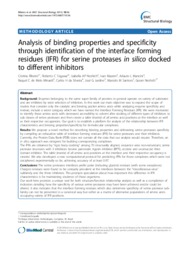Analysis of binding properties and specificity through identification of the interface forming residues (IFR) for serine proteases in silico docked to different inhibitors.
Analysis of binding properties and specificity through identification of the interface forming residues (IFR) for serine proteases in silico docked to different inhibitors.
Author(s): RIBEIRO, C.; TOGAWA, R. C.; NESHICH, I. A. P.; MAZONI, I.; MANCINI, A. L.; MINARDI, R. C. de M.; SILVEIRA, C. H. da; JARDINE, J. G.; SANTORO, M. M.; NESHICH, G.
Summary: Background: Enzymes belonging to the same super family of proteins in general operate on variety of substrates and are inhibited by wide selection of inhibitors. In this work our main objective was to expand the scope of studies that consider only the catalytic and binding pocket amino acids while analyzing enzyme specificity and instead, include a wider category which we have named the Interface Forming Residues (IFR). We were motivated to identify those amino acids with decreased accessibility to solvent after docking of different types of inhibitors to sub classes of serine proteases and then create a table (matrix) of all amino acid positions at the interface as well as their respective occupancies. Our goal is to establish a platform for analysis of the relationship between IFR characteristics and binding properties/specificity for bi-molecular complexes. Results: We propose a novel method for describing binding properties and delineating serine proteases specificity by compiling an exhaustive table of interface forming residues (IFR) for serine proteases and their inhibitors. Currently, the Protein Data Bank (PDB) does not contain all the data that our analysis would require. Therefore, an in silico approach was designed for building corresponding complexes The IFRs are obtained by ?rigid body docking? among 70 structurally aligned, sequence wise non-redundant, serine protease structures with 3 inhibitors: bovine pancreatic trypsin inhibitor (BPTI), ecotine and ovomucoid third domain inhibitor. The table (matrix) of all amino acid positions at the interface and their respective occupancy is created. We also developed a new computational protocol for predicting IFRs for those complexes which were not deciphered experimentally so far, achieving accuracy of at least 0.97. Conclusions: The serine proteases interfaces prefer polar (including glycine) residues (with some exceptions). Charged residues were found to be uniquely prevalent at the interfaces between the ?miscellaneous-virus? subfamily and the three inhibitors. This prompts speculation about how important this difference in IFR characteristics is for maintaining virulence of those organisms. Our work here provides a unique tool for both structure/function relationship analysis as well as a compilation of indicators detailing how the specificity of various serine proteases may have been achieved and/or could be altered. It also indicates that the interface forming residues which also determine specificity of serine protease sub-family can not be presented in a canonical way but rather as a matrix of alternative populations of amino acids occupying variety of IFR positions.
Publication year: 2010
Types of publication: Journal article
Observation
Some of Embrapa's publications are published as ePub files. To read them, use or download one of the following free software options to your computer or mobile device. Android: Google Play Books; IOS: iBooks; Windows and Linux: Calibre.
Access other publications
Access the Agricultural Research Database (BDPA) to consult Embrapa's full library collection and records.
Visit Embrapa Bookstore to purchase books and other publications sold by Embrapa.

